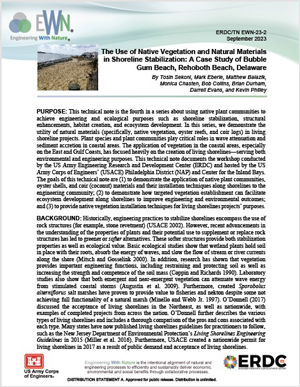This technical note is the fourth in a series about using native plant communities to achieve engineering and ecological purposes such as shoreline stabilization, structural enhancements, habitat creation, and ecosystem development. In this series, we demonstrate the utility of natural materials (specifically, native vegetation, oyster reefs, and coir logs) in living shoreline projects. Plant species and plant communities play critical roles in wave attenuation and sediment accretion in coastal areas. The application of vegetation in the coastal areas, especially on the East and Gulf Coasts, has focused heavily on the creation of living shorelines—serving both environmental and engineering purposes. This technical note documents the workshop conducted by the US Army Engineering Research and Development Center (ERDC) and hosted by the US Army Corps of Engineers’ (USACE) Philadelphia District (NAP) and Center for the Inland Bays. The goals of this technical note are (1) to demonstrate the application of native plant communities, oyster shells, and coir (coconut) materials and their installation techniques along shorelines to the engineering community; (2) to demonstrate how targeted vegetation establishment can facilitate ecosystem development along shorelines to improve engineering and environmental outcomes; and (3) to provide native vegetation installation techniques for living shorelines projects’ purposes.


